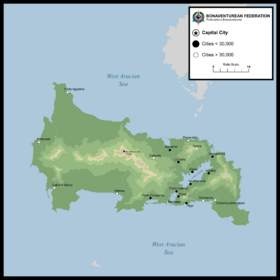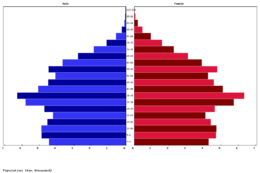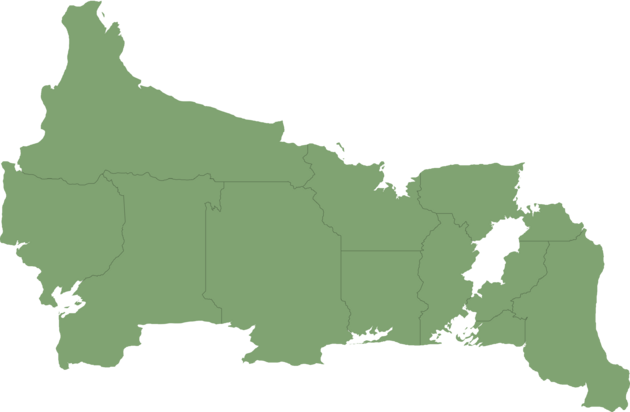Bonaventura
Bonaventurean Federation Vespasian: Federazione Bonaventurana | |
|---|---|
| Motto: "Negare e triunfare" (Estmerish: To deny and to triumph) | |
| Anthem: "Madrepatria" (Estmerish: Motherland) | |
 Location of Bonaventura in the West Arucian Sea in green. | |
 Detailed map of Bonaventure | |
| Capital and | Sermoni |
| Official languages | Vespasian |
| Recognised national languages | |
| Recognised regional languages | |
| Ethnic groups (2020) |
|
| Demonym(s) | Bonaventurean |
| Government | Federative presidential republic |
• President | Vinicio Nardiello |
• Vice President | Liberio Ceci |
• President of National Assembly | Euseo Di Marino |
| Legislature | National Assembly |
| Formation | |
| Area | |
• | 40,015.36 km2 (15,450.02 sq mi) |
| Population | |
• 2020 estimate | 3,299,034 |
• Density | 82.44/km2 (213.5/sq mi) |
| GDP (PPP) | 2020 estimate |
• Total | $50,378,555,599 |
• Per capita | $15,271 |
| GDP (nominal) | 2020 estimate |
• Total | $26,368,659,217 |
• Per capita | $7,993 |
| HDI (2020) | 0.796 high |
| Currency | Arucian shilling (ſ) (ARS) |
| Date format | dd-mm-yyyy |
| Driving side | right |
| Calling code | +5 |
| ISO 3166 code | BON |
| Internet TLD | .bv |
Bonaventure (Vespasian: Bonaventura), also known as the Bonaventurean Federation (Vespasian: Federazione Bonaventurana) is a sovereign island nation located in the West Arucian sea, in between the continents of Asteria Superior and Asteria Inferior. Bonaventure has maritime borders with Ardesia to the north, Aucuria to the southeast, Eldmark to the west, and Imagua and the Assimas to the south, with whom Bonaventure has a territory dispute over the small Dunhelm Island. As of 2020, Bonaventure has a population of 3,3 million people, and a land area of 40,015.36 square kilometers, being the second biggest and second most populated of the Arucian islands. The capital and biggest city of Bonaventure is the city of Sermoni, located in the .?.?.? bay, in the southern coast of the island.
The island has been populated by the Natí people since 200 BCE and experience an increase in their population during 9th century CE. During the same time, the Zapoyan Empire landed in Bonaventure's northern coast, and quickly established the land as an important location for the seafare commerce in the Arucian Sea. While the Zapoyan influence in Bonaventure grew exponentially, many other Arucian people such as the Natí and the Marai could be found in the island, given it was the Zapoyan's main commercial point within the Arucian Sea. The island remained under the control of the Zapoyans until Assim Asteris and his expedition first harboured in Bonaventure. The Etrurian occupation of the Assimas Island also drove their attention to the Bonaventure. The first Etrurian settlement in Bonaventure was established in 1523, and the Insular War of 1536, led by Giacomo Borghese, put and end on the Zapoyan rule of the island and settled Bonaventure as the Etrurian colony of New Accadia.
New Accadia remained a colony until October 6th, 1946, when Etruria's defeat in the Solarian War put an end to their colonial empire. Eleven days following its independence, New Accadia was acquired and taken as part of the United Provinces of the Western Arucian Islands. The United Provinces remained united until the departure of Imagua and the Assimas, in 1948, and it dissoluted permanently in 1954, with the departure of Sainte-Chloé and Carucere after a constitutional crisis within the Union. New Accadia carried on the name of United Provinces for about 1 year and 3 months after its independence, when a popular referendum voted that the newly sovereign island would be named after the independence war hero, Quarto Bonaventura.
Bonaventure is a volcanic island that lays on the Arucian faultline, a divergent plate boundry between the .?.?.? and the .?.?.? plates. Such conditions have resulted in the formation of the Iacattuotili Valley, alongside the formation of Lake Attila, the biggest and deepest lake in the Arucian island. This geographic placement, however, has affected Bonaventure with many natural disasters including the 1804 Sermoni earthquake, and the 2020 Mount Micchiano eruption.
Bonaventure has the second biggest nominal GDP amongst the Arucian Nations at $26,3 billion, but the second lowest nominal GDP per capita at $7.993. The nation has experience in the service sector, with emphasis in the tourism and financial services. Bonaventure has been attractive to international investors due to its liberal economy and area size, however the 2020 Mount Micchiano eruption caused a tremendous shock to the national economy, and Bonaventure has been in an extensive economic crisis since then. Bonaventure is a member of the Community of Nations, the Organization of Asterian Nations, and co-founder of the Arucian Cooperation Organization.
Etymology
Bonaventure has gone through some name changes throughout the years prior to its current one. For instance, the first record of a name for the island was Chalma. According to linguists, the name is a reference to the Zapoyan term “Chalmecacihuatl,” which translated to the “Women from Chalmeca,” a Zapoyan deity who was worshiped by merchants as the sister of the merchant god, Yacateuctli, and also as the the goddess of “water and earth.” Following the fall of the Zapoyan Empire and the Etrurian conquest in 1536 saw the island being renamed to “New Accadia,” as a celebration to the several families natural from the Etrurian city of Accadia that arrived in the city of Sermoni in January 1538 to permanently populate the location. The colony would keep its name until October 17th, 1946, when the newley independent nation joined the United Provinces of the West Arucian Islands. The name was a reference to all of the Western Arucian islands that united to establish of the United Provinces.
The current name was a suggestion made by Ireneo Zaccaria, a former history professor in the Sermoni University, when the national government opened a contest to select three names for a referendum to change the name of the Island following the dissolution of the United Provinces in 1954. Amongst the over 100 names submitted, Bonaventura, alongside Nuova Cialma and Azzalia were the selected finalists. Ultimately, the name “Bonaventura” was the most voted and it was officially put into effect in January 1st, 1956. According to Professor Zaccaria, the reason for suggesting the name “Bonaventura” was a way to honor the image and doings of Quarto Bonaventura, a man seen by the people of the island as a war hero, a martyr, and a liberator of Bonaventura during the Independence Wars, on top of having a linguistically meaning “land of good fortune,” as bona seems to be a variant of the Vespasian buona (good), and ventura seems to be a variant of the Vespasian fortuna (luck, good fortune). Some historians also argue that the real reason for choosing the name “Bonaventura” is a reference to the Ship Bonaventura, one of the very first Etrurian expeditions to the island led by captain Benvenuto Viscuso, natural from the small Etrurian city of Paci, who’s patron saint is the catholic Saint Bonaventura; the massive part of historians do not attest for this theory and generally accord with Professor Zaccaria’s explanation instead.
History
Geography
Climate
Biodiversity
Demographics

The population of Bonaventure, according to the 2020 census made by the Bonaventurean Institute of Geography and Statistics (IBGS), was 3,299,034 habitants (82.4 per square kilometer), with a proportion between men and women as 0.86:1 and over 80% of the population living in the cities. The population is strongly located in the southern region (Rivermouth region), home to over 2 million people, accounting for about 62% of the country's total population. The biggest urban areas of Bonaventure, according to the estimative made by IBGS as of 2020, are the metropolitan areas of the national capital Sermoni (857,732), Fava (392,663), Appano (184,651), Porto Gamba (167,045), and Riga (163,222).
The Bonaventurean population had a significant growth between the late 1890s and early 1940, with a significant deacceleration in the following decades due to the successive economic crises affecting the country during the late 20th century. The low birth rate alongside the growing Bonaventurean diaspora has resulted in a recurring negative population growth since the 2010s. Nowadays, the birth rate of Bonaventure is 7.5/1,000, amongst the lowest in the world. The life expectancy is of 78,28 years; the expected years of education for Bonaventure is 13.3 years, while the mean years of education is of 11 years; the GDP PPP per capita of Bonaventure is of approximately $15.3 thousands. The Bonaventurean HDI is 0.791, considered high and ranking as the second best in the West Arucian region.
| Rank | State | Pop. | |||||||
|---|---|---|---|---|---|---|---|---|---|
 Sermoni  Fava |
1 | Sermoni | Federal District | 857,732 |  Appano  Porto Gamba | ||||
| 2 | Fava | Missioni | 392,663 | ||||||
| 3 | Appano | Poveromo | 184,651 | ||||||
| 4 | Porto Gamba | Santa Croce | 167,045 | ||||||
| 5 | Riga | San Giorgio | 163,222 | ||||||
| 6 | Accapucchi | Montecalvo | 132,029 | ||||||
| 7 | La Valla | Setinattia | 109,937 | ||||||
| 8 | Iecattia | Conucco | 101,838 | ||||||
| 9 | Quattecchia | San Gaetano | 90,224 | ||||||
| 10 | Sacra | Attila | 67,882 | ||||||
| Historical population | ||
|---|---|---|
| Year | Pop. | ±% |
| 1765 | 44,883 | — |
| 1775 | 70,250 | +56.5% |
| 1800 | 155,426 | +121.2% |
| 1815 | 220,892 | +42.1% |
| 1832 | 350,051 | +58.5% |
| 1846 | 447,914 | +28.0% |
| 1860 | 583,308 | +30.2% |
| 1877 | 731,648 | +25.4% |
| 1887 | 798,565 | +9.1% |
| 1899 | 953,243 | +19.4% |
| 1910 | 1,118,012 | +17.3% |
| 1920 | 1,299,809 | +16.3% |
| 1930 | 1,543,913 | +18.8% |
| 1940 | 1,869,255 | +21.1% |
| 1950 | 2,210,703 | +18.3% |
| 1960 | 2,349,544 | +6.3% |
| 1970 | 2,712,033 | +15.4% |
| 1980 | 3,196,520 | +17.9% |
| 1990 | 3,522,037 | +10.2% |
| 2000 | 3,808,610 | +8.1% |
| 2010 | 3,725,789 | −2.2% |
| 2020 | 3,285,874 | −11.8% |
Ethnicities
Religion
Languages
Government & Politics
Law
Armed forces
Crime and law enforcement
International relations
Sub-divisions
TEXTHERE


